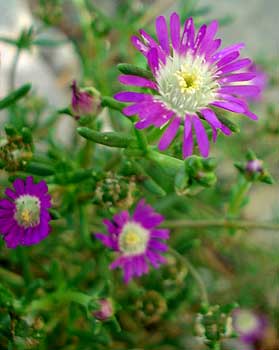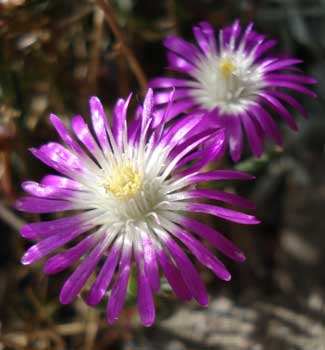
'Starburst'
Hardy Ice Plant
"Does not attachment to spiritual things
Hold us to this wheel of anguish
As surely as attachment to possessions?
I am deeply attached to the shrine's gardens.
Therein, I feel myself sufficiently liberated
And no longer seek enlightenment."
-Tsuki Izutsu,
fl. 1138
Resembling the most often seen hardy ice plant Delosperma cooperi, D. floribunda 'Starburst' has the same metallic-pink aster-like blossoms, but with a big white center that renders it distinctive.fl. 1138
These blooms additionally lift up on four to six inch stems, unlike most ice plants with the flowers practically laying on the thick mat of green succulent leaves.
Introduced into North American gardening by Panayoti Kelaidis of the Denver Botanic Garden, 'Starburst' though given as the cultivar name seems really to just be the wild species. A patented cultivar 'Balosquin' is available under the trademark name 'Sequins,' but I can't see that it has any distinctive qualities to set it apart from 'Starburst.'
 It is blooming by June & continues to flower until the first hard frost of Autumn. The semi-evergreen succulent foliage is a spreading mat only four or five inches tall, though flowers may reach up six or seven inches.
It is blooming by June & continues to flower until the first hard frost of Autumn. The semi-evergreen succulent foliage is a spreading mat only four or five inches tall, though flowers may reach up six or seven inches.This ice plant is easy to grow in zones 6 through 9, with possibility down to chilly zone 5. In the hottest summers like in the American Southwest, it may want a tiny bit of protection from the longest hottest days, but in general wants fullest sun, the blooms remaining open only in bright sunlight.
Here in the Pacific Northwest, with our rainy winters, radically well-draining soil is a must; damp feet will kill it, but in soil that drains perfectly it's unkillable. Even if some winters it dies back a bit, it returns in spring, & most winters it is just a dormant evergreen mat. Like all ice plants it seems to be impervious to insect attack & just generally healthy without much attention.
Ours is growing in a narrow raised trough that encircles a tall planter, raised about six inches insuring the sharp drainage it requires.
The species is native to the Orange Free State of South Africa, where ice plants are often called "carpet weeds" & taken very much granted.
Only rarely noted by nurseries & propagators, perhaps for fear of this excellent xeric garden plant being made a "controlled substance," the genus is a source of dimethyltryptamine or DMT, a psychedelic drug. Purportedly, it has been used by African tribal peoples for ritually vision-inducing experiences.
Yet the psychotropic drug content of the plant is very slight & without extraction & purifying capacity, it would never induce a peyote high. Reports that it is a mellowing agent if a single leaf is inserted into a cigarette & smoked strike me as the equivalent of that 1960s hippy rumor that baked banana peels are a good marijuana substitute.